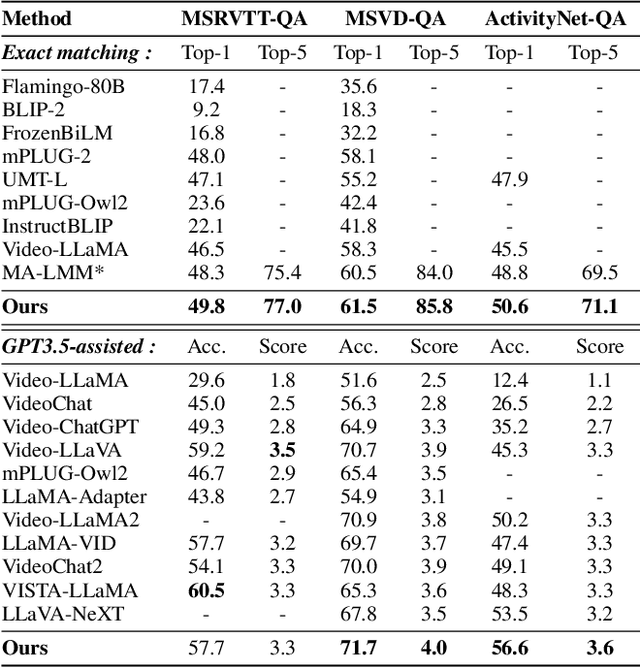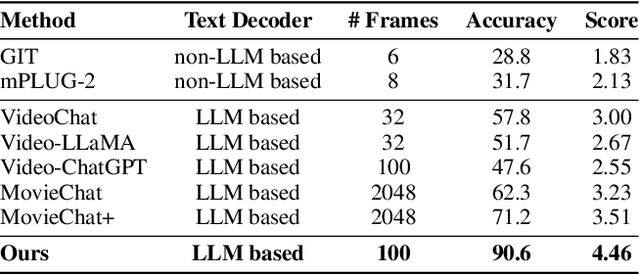Jingyu Liu
Multi-Object Sketch Animation by Scene Decomposition and Motion Planning
Mar 25, 2025Abstract:Sketch animation, which brings static sketches to life by generating dynamic video sequences, has found widespread applications in GIF design, cartoon production, and daily entertainment. While current sketch animation methods perform well in single-object sketch animation, they struggle in multi-object scenarios. By analyzing their failures, we summarize two challenges of transitioning from single-object to multi-object sketch animation: object-aware motion modeling and complex motion optimization. For multi-object sketch animation, we propose MoSketch based on iterative optimization through Score Distillation Sampling (SDS), without any other data for training. We propose four modules: LLM-based scene decomposition, LLM-based motion planning, motion refinement network and compositional SDS, to tackle the two challenges in a divide-and-conquer strategy. Extensive qualitative and quantitative experiments demonstrate the superiority of our method over existing sketch animation approaches. MoSketch takes a pioneering step towards multi-object sketch animation, opening new avenues for future research and applications. The code will be released.
PGAD: Prototype-Guided Adaptive Distillation for Multi-Modal Learning in AD Diagnosis
Mar 05, 2025Abstract:Missing modalities pose a major issue in Alzheimer's Disease (AD) diagnosis, as many subjects lack full imaging data due to cost and clinical constraints. While multi-modal learning leverages complementary information, most existing methods train only on complete data, ignoring the large proportion of incomplete samples in real-world datasets like ADNI. This reduces the effective training set and limits the full use of valuable medical data. While some methods incorporate incomplete samples, they fail to effectively address inter-modal feature alignment and knowledge transfer challenges under high missing rates. To address this, we propose a Prototype-Guided Adaptive Distillation (PGAD) framework that directly incorporates incomplete multi-modal data into training. PGAD enhances missing modality representations through prototype matching and balances learning with a dynamic sampling strategy. We validate PGAD on the ADNI dataset with varying missing rates (20%, 50%, and 70%) and demonstrate that it significantly outperforms state-of-the-art approaches. Ablation studies confirm the effectiveness of prototype matching and adaptive sampling, highlighting the potential of our framework for robust and scalable AD diagnosis in real-world clinical settings.
Speculative Prefill: Turbocharging TTFT with Lightweight and Training-Free Token Importance Estimation
Feb 05, 2025



Abstract:Improving time-to-first-token (TTFT) is an essentially important objective in modern large language model (LLM) inference engines. Because optimizing TTFT directly results in higher maximal QPS and meets the requirements of many critical applications. However, boosting TTFT is notoriously challenging since it is purely compute-bounded and the performance bottleneck shifts from the self-attention to the MLP part. We present SpecPrefill, a training free framework that accelerates the inference TTFT for both long and medium context queries based on the following insight: LLMs are generalized enough to still preserve the quality given only a carefully chosen subset of prompt tokens. At its core, SpecPrefill leverages a lightweight model to speculate locally important tokens based on the context. These tokens, along with the necessary positional information, are then sent to the main model for processing. We evaluate SpecPrefill with a diverse set of tasks, followed by a comprehensive benchmarking of performance improvement both in a real end-to-end setting and ablation studies. SpecPrefill manages to serve Llama-3.1-405B-Instruct-FP8 with up to $7\times$ maximal end-to-end QPS on real downstream tasks and $7.66\times$ TTFT improvement during benchmarking.
ECGN: A Cluster-Aware Approach to Graph Neural Networks for Imbalanced Classification
Oct 15, 2024Abstract:Classifying nodes in a graph is a common problem. The ideal classifier must adapt to any imbalances in the class distribution. It must also use information in the clustering structure of real-world graphs. Existing Graph Neural Networks (GNNs) have not addressed both problems together. We propose the Enhanced Cluster-aware Graph Network (ECGN), a novel method that addresses these issues by integrating cluster-specific training with synthetic node generation. Unlike traditional GNNs that apply the same node update process for all nodes, ECGN learns different aggregations for different clusters. We also use the clusters to generate new minority-class nodes in a way that helps clarify the inter-class decision boundary. By combining cluster-aware embeddings with a global integration step, ECGN enhances the quality of the resulting node embeddings. Our method works with any underlying GNN and any cluster generation technique. Experimental results show that ECGN consistently outperforms its closest competitors by up to 11% on some widely studied benchmark datasets.
EITNet: An IoT-Enhanced Framework for Real-Time Basketball Action Recognition
Oct 13, 2024Abstract:Integrating IoT technology into basketball action recognition enhances sports analytics, providing crucial insights into player performance and game strategy. However, existing methods often fall short in terms of accuracy and efficiency, particularly in complex, real-time environments where player movements are frequently occluded or involve intricate interactions. To overcome these challenges, we propose the EITNet model, a deep learning framework that combines EfficientDet for object detection, I3D for spatiotemporal feature extraction, and TimeSformer for temporal analysis, all integrated with IoT technology for seamless real-time data collection and processing. Our contributions include developing a robust architecture that improves recognition accuracy to 92\%, surpassing the baseline EfficientDet model's 87\%, and reducing loss to below 5.0 compared to EfficientDet's 9.0 over 50 epochs. Furthermore, the integration of IoT technology enhances real-time data processing, providing adaptive insights into player performance and strategy. The paper details the design and implementation of EITNet, experimental validation, and a comprehensive evaluation against existing models. The results demonstrate EITNet's potential to significantly advance automated sports analysis and optimize data utilization for player performance and strategy improvement.
TRACE: Temporal Grounding Video LLM via Causal Event Modeling
Oct 08, 2024



Abstract:Video Temporal Grounding (VTG) is a crucial capability for video understanding models and plays a vital role in downstream tasks such as video browsing and editing. To effectively handle various tasks simultaneously and enable zero-shot prediction, there is a growing trend in employing video LLMs for VTG tasks. However, current video LLM-based methods rely exclusively on natural language generation, lacking the ability to model the clear structure inherent in videos, which restricts their effectiveness in tackling VTG tasks. To address this issue, this paper first formally introduces causal event modeling framework, which represents videos as sequences of events, and predict the current event using previous events, video inputs, and textural instructions. Each event consists of three components: timestamps, salient scores, and textual captions. We then propose a novel task-interleaved video LLM called TRACE to effectively implement the causal event modeling framework in practice. The TRACE processes visual frames, timestamps, salient scores, and text as distinct tasks, employing various encoders and decoding heads for each. Task tokens are arranged in an interleaved sequence according to the causal event modeling framework's formulation. Extensive experiments on various VTG tasks and datasets demonstrate the superior performance of TRACE compared to state-of-the-art video LLMs. Our model and code are available at \url{https://github.com/gyxxyg/TRACE}.
PalmBench: A Comprehensive Benchmark of Compressed Large Language Models on Mobile Platforms
Oct 05, 2024



Abstract:Deploying large language models (LLMs) locally on mobile devices is advantageous in scenarios where transmitting data to remote cloud servers is either undesirable due to privacy concerns or impractical due to network connection. Recent advancements (MLC, 2023a; Gerganov, 2023) have facilitated the local deployment of LLMs. However, local deployment also presents challenges, particularly in balancing quality (generative performance), latency, and throughput within the hardware constraints of mobile devices. In this paper, we introduce our lightweight, all-in-one automated benchmarking framework that allows users to evaluate LLMs on mobile devices. We provide a comprehensive benchmark of various popular LLMs with different quantization configurations (both weights and activations) across multiple mobile platforms with varying hardware capabilities. Unlike traditional benchmarks that assess full-scale models on high-end GPU clusters, we focus on evaluating resource efficiency (memory and power consumption) and harmful output for compressed models on mobile devices. Our key observations include i) differences in energy efficiency and throughput across mobile platforms; ii) the impact of quantization on memory usage, GPU execution time, and power consumption; and iii) accuracy and performance degradation of quantized models compared to their non-quantized counterparts; and iv) the frequency of hallucinations and toxic content generated by compressed LLMs on mobile devices.
How Much Can RAG Help the Reasoning of LLM?
Oct 03, 2024Abstract:Retrieval-Augmented Generation (RAG) has gained significant popularity in modern Large Language Models (LLMs) due to its effectiveness in introducing new knowledge and reducing hallucinations. However, the deep understanding of RAG remains limited, how does RAG help the reasoning process and can RAG help improve the reasoning capability remains question. While external documents are typically considered as a method to incorporate domain-specific information, they also contain intermediate reasoning results related to the query, this suggests that documents could enhance the reasoning capability of LLMs, which has not been previously explored. In this paper, we investigate this issue in depth and find that while RAG can assist with reasoning, the help is limited. If we conceptualize the reasoning process as a tree with fixed depth, then RAG struggles to assist LLMs in performing deeper reasoning. Additionally, the information in the documents requires preprocessing to filter out noise. We demonstrate that this preprocessing is difficult to achieve simply fine-tuning of the LLM, it often necessitates numerous additional transformer layers to solve the problem. To simplify the problem, we propose DPrompt tuning, which effectively resolves the issue within just limited transformer layers, leading to improved performance.
Enhancing Long Video Understanding via Hierarchical Event-Based Memory
Sep 10, 2024



Abstract:Recently, integrating visual foundation models into large language models (LLMs) to form video understanding systems has attracted widespread attention. Most of the existing models compress diverse semantic information within the whole video and feed it into LLMs for content comprehension. While this method excels in short video understanding, it may result in a blend of multiple event information in long videos due to coarse compression, which causes information redundancy. Consequently, the semantics of key events might be obscured within the vast information that hinders the model's understanding capabilities. To address this issue, we propose a Hierarchical Event-based Memory-enhanced LLM (HEM-LLM) for better understanding of long videos. Firstly, we design a novel adaptive sequence segmentation scheme to divide multiple events within long videos. In this way, we can perform individual memory modeling for each event to establish intra-event contextual connections, thereby reducing information redundancy. Secondly, while modeling current event, we compress and inject the information of the previous event to enhance the long-term inter-event dependencies in videos. Finally, we perform extensive experiments on various video understanding tasks and the results show that our model achieves state-of-the-art performances.
TC-LLaVA: Rethinking the Transfer from Image to Video Understanding with Temporal Considerations
Sep 05, 2024Abstract:Multimodal Large Language Models (MLLMs) have significantly improved performance across various image-language applications. Recently, there has been a growing interest in adapting image pre-trained MLLMs for video-related tasks. However, most efforts concentrate on enhancing the vision encoder and projector components, while the core part, Large Language Models (LLMs), remains comparatively under-explored. In this paper, we propose two strategies to enhance the model's capability in video understanding tasks by improving inter-layer attention computation in LLMs. Specifically, the first approach focuses on the enhancement of Rotary Position Embedding (RoPE) with Temporal-Aware Dual RoPE, which introduces temporal position information to strengthen the MLLM's temporal modeling capabilities while preserving the relative position relationships of both visual and text tokens. The second approach involves enhancing the Attention Mask with the Frame-wise Block Causal Attention Mask, a simple yet effective method that broadens visual token interactions within and across video frames while maintaining the causal inference mechanism. Based on these proposed methods, we adapt LLaVA for video understanding tasks, naming it Temporal-Considered LLaVA (TC-LLaVA). Our TC-LLaVA achieves new state-of-the-art performance across various video understanding benchmarks with only supervised fine-tuning (SFT) on video-related datasets.
 Add to Chrome
Add to Chrome Add to Firefox
Add to Firefox Add to Edge
Add to Edge